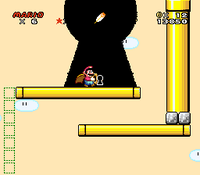Keyhole: Difference between revisions
(Undo revision 2969500 by Abraham2204 (talk) Not relevant. Adjusting music/effects can cause it to sound like several things.) Tag: Undo |
mNo edit summary |
||
| (24 intermediate revisions by 10 users not shown) | |||
| Line 1: | Line 1: | ||
[[File:Keyhole exit SMW.png|thumb|Mario puts the key in the keyhole.]] | [[File:Keyhole exit SMW.png|thumb|Mario puts the key in the keyhole in [[Donut Plains 1]].]] | ||
''' | A '''keyhole'''<ref>{{cite|title=''Super Mario World'' instruction booklet|page=6 and 21|date=1991|publisher=Nintendo of America|language=en-us}}</ref> (also formatted in uppercase)<ref>{{cite|title=''Nintendo Power'' Volume 28|page=16|language=en-us|publisher=Nintendo of America|date=September 1991}}</ref> appears in ''[[Super Mario World]]'' and [[Super Mario World: Super Mario Advance 2|its reissue]] as a secret [[level]] passage. Every level represented by a red dot on the map contains a secret exit; in most such levels, the secret exit is through a keyhole. While lacking a red dot, several [[Ghost House]]s also have secret exits, with [[Valley Ghost House|one among them]] being via a keyhole as well. To achieve a secret exit via a keyhole, the player must find a [[key]] (usually hidden in the main course somewhere) and bring it to the keyhole. If [[Mario]] or [[Luigi]] is riding [[Yoshi]], Yoshi can hold the key in his mouth and simply walk to the keyhole. When activated by the key, the keyhole grows in size and swallows up Mario or Luigi, along with Yoshi if the player is riding him. | ||
One keyhole | One keyhole appears in the [[Super Mario World (television series)|''Super Mario World'' animated television series]] during part of the episode "[[Mama Luigi]]." Yoshi, who is a [[Baby Yoshi]] at this point, eats a key held by [[Bowser|King Koopa]]. After King Koopa flees, Yoshi spits it out into a nearby keyhole on the wall. The action of the two coming into contact suddenly transports Mario, Luigi, Yoshi, and [[Princess Peach|Princess Toadstool]] back to [[Dome City]]. | ||
==Gallery== | |||
<gallery> | |||
SMA2 Opened Keyhole.png|''[[Super Mario World: Super Mario Advance 2]]'' | |||
SMW Cartoon Keyhole.jpg|[[Super Mario World (television series)|''Super Mario World'' television series]] ("[[Mama Luigi]]") | |||
</gallery> | |||
==Names in other languages== | ==Names in other languages== | ||
{{foreign names | {{foreign names | ||
|Jap=カギ | |Jap=カギ{{ruby|穴|あな}}<ref>''Super Mario World'' Japanese instruction booklet (fold-out)</ref> | ||
|JapR=Kagi Ana | |JapR=Kagi Ana | ||
|JapM=Keyhole | |JapM=Keyhole | ||
| | |Fre=Trou de Serrure | ||
| | |FreM=Key hole | ||
|Ger=Schlüsselloch | |Ger=Schlüsselloch | ||
|GerM=Keyhole | |GerM=Keyhole | ||
|Ita=Buco della serratura | |Ita=Buco della serratura | ||
|ItaM=Keyhole | |Ita2=Serratura | ||
|ItaM=Key hole | |||
|Ita2M=Keyhole | |||
|Por=Buraco de fechadura | |Por=Buraco de fechadura | ||
|PorM=Keyhole | |PorM=Keyhole | ||
|Spa=El ojo de la cerradura | |||
|SpaM=Keyhole | |||
}} | }} | ||
==References== | ==References== | ||
<references/> | <references/> | ||
{{Goals}} | {{Goals}} | ||
{{SMW}} | {{SMW}} | ||
[[Category:Goals]] | [[Category:Goals]] | ||
[[Category:Super Mario World | [[Category:Super Mario World objects]] | ||
[[de:Schlüsselloch]] | [[de:Schlüsselloch]] | ||
Latest revision as of 23:55, July 4, 2024

A keyhole[1] (also formatted in uppercase)[2] appears in Super Mario World and its reissue as a secret level passage. Every level represented by a red dot on the map contains a secret exit; in most such levels, the secret exit is through a keyhole. While lacking a red dot, several Ghost Houses also have secret exits, with one among them being via a keyhole as well. To achieve a secret exit via a keyhole, the player must find a key (usually hidden in the main course somewhere) and bring it to the keyhole. If Mario or Luigi is riding Yoshi, Yoshi can hold the key in his mouth and simply walk to the keyhole. When activated by the key, the keyhole grows in size and swallows up Mario or Luigi, along with Yoshi if the player is riding him.
One keyhole appears in the Super Mario World animated television series during part of the episode "Mama Luigi." Yoshi, who is a Baby Yoshi at this point, eats a key held by King Koopa. After King Koopa flees, Yoshi spits it out into a nearby keyhole on the wall. The action of the two coming into contact suddenly transports Mario, Luigi, Yoshi, and Princess Toadstool back to Dome City.
Gallery[edit]
Names in other languages[edit]
| Language | Name | Meaning | Notes |
|---|---|---|---|
| Japanese | カギ Kagi Ana |
Keyhole | |
| French | Trou de Serrure[?] | Key hole | |
| German | Schlüsselloch[?] | Keyhole | |
| Italian | Buco della serratura[?] | Key hole | |
| Serratura[?] | Keyhole | ||
| Portuguese | Buraco de fechadura[?] | Keyhole | |
| Spanish | El ojo de la cerradura[?] | Keyhole |

